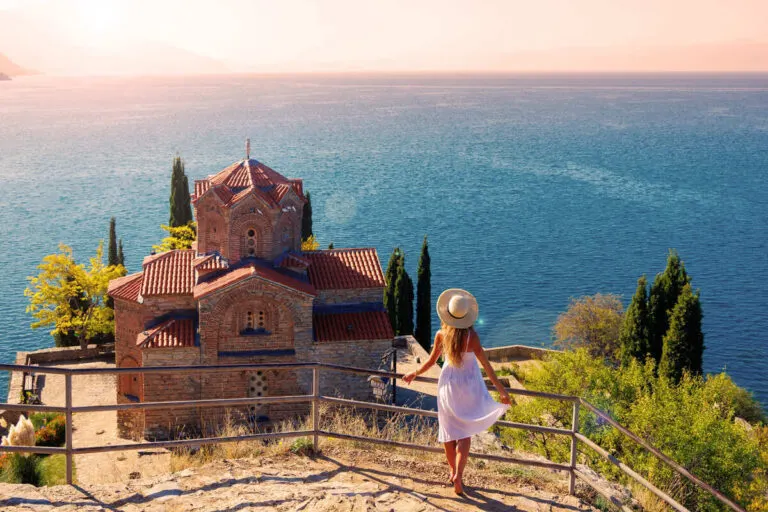Southern Europe seems to be on everyone’s radar this summer now that the weather is warmer, days are getting longer, and Transatlantic routes are relaunching to some of the region’s most exciting destinations, from the Côte d’Azur down to Amalfi.
What if we told you, however, that one of the trendiest sunny destinations in the Old Continent is not Mediterranean?
As great as they may be, France, Italy and the like are currently drowning in overtourism, and the surging vacation costs make them less and less appealing each passing year.
With ancient ruins and a glistening lake with turquoise water, it’s the unexpected, budget-friendly Ohrid that’s come to save the day:
The Beautiful European Town On The Shores Of A Turquoise Lake

Ohrid is a charming lakeside town in the unheard-of country of North Macedonia, located in the heart of the Balkan Peninsula, just north of Greece and east of Croatia and Montenegro, if geography isn’t your forte.
Despite being neighbors with several of Europe’s most popular beach getaways, North Macedonia is landlocked, and for that very specific reason, it tends to be largely overlooked by sun-seeking country-hoppers.

But then again, it’s not like most of them would know it lays claim to a vast, pristine lake, one of Europe’s deepest and largest, with waters so clear it rivals the Mediterranean basin and a cheaper alternative to the jam-packed coast.
The Bacalar Of Europe
Variously described as Bacalar of Europe, in reference to Mexico’s up-and-coming lake getaway, or Jerusalem of the Balkans, owing it to a high concentration of historic monuments, Ohrid straddles the bank of the namesake lake.

It has 365 churches, one for each day of the year, some dating back to Ancient Greece.
It’s one of only a handful of UNESCO World Heritage Sites that has achieved this status based on its cultural heritage and natural beauty.
If you’ve ever wondered where that solitary Byzantine church perched on a cliff overlooking an idyllic body of water is located, you needn’t look any further.
You’ll find it right here in Ohrid, and it just happens to be the town’s most iconic landmark.

You shouldn’t be too surprised at how the Old Town looks so well-preserved, either.
Unlike other parts of the Balkans, which have had a modernist makeover in the 20th century, Ohrid has remained virtually unchanged.
The cobblestones between the Ottoman houses, the partially-exposed Greek theater built in the immemorial 2nd century BC, the Romanesque Church of Saint Sophia, and the monumental Samuel’s Fortress have all survived the passing of time, nearly intact.
A World-Class Beach Destination

There are, quite literally, too many historic sites in Ohrid to count, and it’s unlikely you’ll be able to see it all in a single visit, especially when you’re likely to want to add in a little beach time:
Lake Ohrid is no sea, but you could easily mistake it for one, considering how hot it gets in North Macedonia in summer and the nature of the water, whose gentle, crystal-clear waves crash against a sand-and-pebble shoreline.

There are even beaches, with the sandy Gradishte being the top pick for families.
It has lakefront hotels, shallow, warm waters, and amusement zones, while the bar-lined Cuba Libre Beach is the nightlife spot, hosting live DJ sets, foam parties, and other events.
And the best thing is, Ohrid is far more peaceful than your average European beach destination.
A Peaceful, Cheap Sunny Getaway

It can get particularly busy at weekends in July, but you’ll notice a majority of tourists are Macedonian natives or Albanians visiting from across the border.
Europeans traveling from further afield, and more rarely even Americans, are rare to come across.
As a result, it still feels more authentic than every other summer hotspot that’s been overtaken by mass tourism.
Considering the local clientele and their lower purchasing power, prices are considerably attractive, to say the least.

An overnight stay at the four-star City Palace in the Old Town costs $64, and that’s one of the most expensive listings in Ohrid.
You can also book yourself an entire luxurious apartment with lake views, managed by a private host for $81 per night.
The five-star lakeside Inex Olgica Hotel & Spa, commanding breathtaking views of Lake Ohrid and equipped with a pool and wellness facilities, is the most expensive stay in the area, and that’s still only $146 per night in the peak of summer.
Food is remarkably inexpensive, too, with meals in local restaurants costing $5-7, and a three-course dinner with drinks averaging $26.36, and trust us, you’ll never go hungry here with their varied selection of Slavic delicacies and even Mediterranean.
For a 3-day stint in Ohrid as a budget traveler, you’re likely to spend just over $100, accommodation and food included; as a mid-range traveler, around $260, and finally for the big spenders who are sold on a weekend at Olgica, a surprisingly affordable $585.
It truly doesn’t get cheaper than this in any other leisure destination in Europe.
How To Get To Ohrid

Ohrid is served by the small St. Paul the Apostle International Airport, hosting low-cost seasonal flights from a number of European cities, such as:
- Belgrade, Serbia
- Zurich, Switzerland
- Katowice, Poland
- Warsaw, Poland
- Amsterdam, Netherlands
- Manchester, United Kingdom
- Dortmund, Germany
- Memmingen, Germany
- Vienna, Austria
Alternatively, visitors can fly into Skopje, the national capital of North Macedonia, where flight frequency is higher, and take a 3-hour bus to Ohrid.
Credit: Source link


